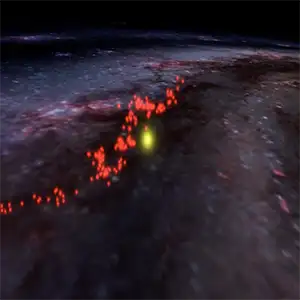
Earth's journey through the Milky Way may have altered our climate
Scientists have determined that around 14 million years ago, our Solar System traveled through a densely populated galactic region and might have experienced increased interstellar dust, which could have influenced Earth’s climate and left signals in geologic layers.
An international research team has uncovered this journey through the Orion star-forming complex, part of the Radcliffe Wave structure.
The experts propose that the Solar System’s passage through this zone could have briefly compressed the heliosphere – the protective bubble surrounding our planetary system – and delivered a greater influx of cosmic material into Earth’s vicinity.
“Imagine it like a ship sailing through varying conditions at sea,” explained Efrem Maconi, lead author and doctoral student at the University of Vienna.
“Our Sun encountered a region of higher gas density as it passed through the Radcliffe Wave in the Orion constellation.”
Solar System’s passage through Orion
Using data from the European Space Agency’s Gaia mission, along with spectroscopic observations, Maconi’s team concluded that this crossing took place about 14 million years ago.
“This discovery builds upon our previous work identifying the Radcliffe Wave,” said João Alves, professor of astrophysics at the University of Vienna and co-author of the study.
The Radcliffe Wave itself is a large-scale, thread-like formation composed of interlinked star-forming zones, of which the Orion complex is a crucial component.

“We passed through the Orion region as well-known star clusters like NGC 1977, NGC 1980, and NGC 1981 were forming,” noted Professor Alves.
“This region is easily visible in the winter sky in the Northern Hemisphere and summer in the Southern Hemisphere. Look for the Orion constellation and the Orion Nebula (Messier 42) – our solar system came from that direction!”
Changes that may still be detectable
During that galactic encounter, Earth would have been exposed to extra amounts of dust.
The scientists propose that such material may have penetrated the planet’s atmosphere, depositing layers that might still be detectable in core samples or other subterranean records.
“While current technology may not be sensitive enough to detect these traces, future detectors could make it possible,” said Professor Alves.
This timing roughly correlates with the Middle Miocene Climate Transition, a period marking Earth’s shift from a warm, fluctuating climate to a cooler, more stable one marked by extensive ice formation in Antarctica.
Interstellar dust and Earth’s climate
Though many factors, including changes in carbon dioxide levels, likely dominated the world’s climate shifts, the authors entertain the notion that cosmic dust from the Orion crossing might have played a supporting part.
“While the underlying processes responsible for the Middle Miocene Climate Transition are not entirely identified, the available reconstructions suggest that a long-term decrease in the atmospheric greenhouse gas carbon dioxide concentration is the most likely explanation, although large uncertainties exist,” Maconi explained.
“However, our study highlights that interstellar dust related to the crossing of the Radcliffe Wave might have impacted Earth’s climate and potentially played a role during this climate transition.”
Maconi noted that, in order to alter the Earth’s climate, the amount of extraterrestrial dust on Earth would need to be much bigger than what the data so far suggest. He said that future research will explore the significance of this contribution.
Past changes vs. modern warming
The experts emphasized that while the Solar System’s trip through Orion may have corresponded with a significant climate phase, it cannot explain the rapid temperature rise currently seen.
Any climate effect from interstellar dust would have taken place slowly, unlike the abrupt, human-caused changes unfolding in the present era.
“It’s crucial to note that this past climate transition and current climate change are not comparable since the Middle Miocene Climate Transition unfolded over timescales of several hundred thousand years,” said Maconi.

“In contrast, the current global warming evolution is happening at an unprecedented rate over decades to centuries due to human activity.”
Still, the notion that cosmic events can appear in Earth’s geological and climatic record opens fresh opportunities for interdisciplinary studies.
Astronomers, geologists, and paleoclimatologists could cooperate more closely to discern whether certain geological anomalies or isotopic variations align with the ancient crossing identified in this work.
Subtle influences on Earth’s climate
“This study is important because it adds a small puzzle piece to the recent history of the Solar System, helping to place it in the context of the Milky Way. We are inhabitants of the Milky Way,” said Professor Alves.
“The European Space Agency’s Gaia Mission has given us the means to trace our recent route in the Milky Way’s interstellar sea, allowing astronomers to compare notes with geologists and paleoclimatologists. It’s very exciting.”
Going forward, the team plans to investigate the specific cosmic environment that the Sun encountered throughout its voyage, focusing on how repeated passages through dense star-forming pockets might intermittently shape Earth’s geological past.
By integrating the latest measurements of cosmic dust, radiometric dating, and climate modeling, they hope to build a clearer narrative of how galactic movements intersect with planetary evolutions.
This research highlights that while Earth’s climate is shaped by forces on our planet, the Sun’s journey through the galaxy can also exert subtle yet fascinating influences.
The study is published in the journal Astronomy and Astrophysics.
—–
Like what you read? Subscribe to our newsletter for engaging articles, exclusive content, and the latest updates.
Check us out on EarthSnap, a free app brought to you by Eric Ralls and Earth.com.
—–













